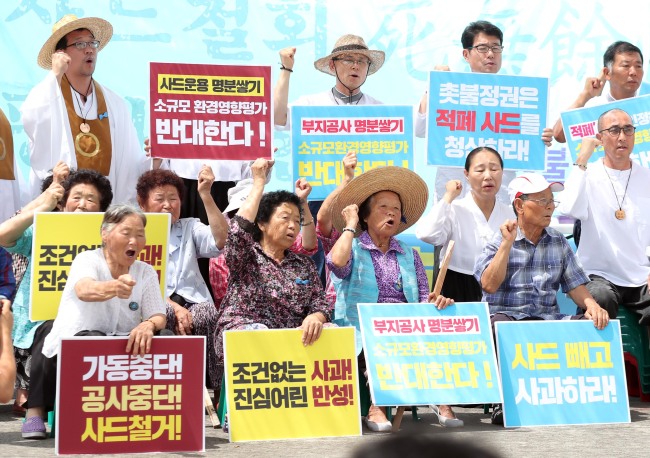Local residents and opponents of the deployment of a US missile shield system Sunday rejected the results of a government-led environmental survey as lacking credibility, posing a challenge to the government’s effort to promptly finish the deployment process amid North Korea’s missile threat.
On Saturday, the government concluded that electromagnetic radiation and noise emanating from the Terminal High Altitude Area Defense system’s advanced X-band radar and power engines prove to be well below the permitted levels, after conducting an environmental assessment.
But residents in Seongju, North Gyeongsang Province, where the THAAD battery is installed, refused to accept the results, claiming that the process was not transparent because it failed to reflect local residents’ opinions.
“We can’t believe the government, who has simply revealed numbers, not the specific process of measuring radiation,” said Kang Hyun-uk, who represents the THAAD opposition groups in Seongju. “After consulting with experts, we will come up with our own measures.”

According to the environmental survey by environment and defense agencies, the THAAD radar’s radiation was far below the regulatory protection standard of 10 watts per square meter during a six-minute test at various distances.
The radiation was measured at 0.01659 watt per square meter at a spot 100 meters from the radar. From 500 meters away, it was 0.004136 watt per square meter. At 700 meters from the radar, the radiation level was 0.000886 watt per square meter. The momentary maximum was 0.04634 watt per square meter.
But the outcome fell short of convincing the Seongju residents of the need to deploy the missile shield, with the residents boycotting the environmental survey and staging protests when the government tried to enter the THAAD site in Seongju.
On Sunday, the Defense Ministry proposed a meeting with local residents this week to find ways to ensure transparency in the THAAD deployment procedure. The residents have yet to respond to the government’s request.
The government had predicted that the environmental assessment result would boost its efforts to fully deploy the THAAD battery, which typically consists of six truck-mounted launchers, an X-band radar, a communication center and a power generator, among other components.
Since the allies decided to deploy THAAD in Seongju last year, local residents and environmentalist activists have asserted that the platform’s radar would emanate harmful magnetic pulses that cause damage to human bodies and that the government should conduct a thorough environmental assessment.
Currently, two THAAD launchers are deployed in Seongju and the remaining four are stored in a US military base in the southern part of the Korean Peninsula. President Moon Jae-in ordered the four launchers to be installed in Seongju following North Korea’s launch of intercontinental ballistic missiles last month.
By Yeo Jun-suk (jasonyeo@heraldcorp.com)








![[KH Explains] Hyundai's full hybrid edge to pay off amid slow transition to pure EVs](http://res.heraldm.com/phpwas/restmb_idxmake.php?idx=644&simg=/content/image/2024/04/18/20240418050645_0.jpg&u=20240419100350)






![[From the Scene] Monks, Buddhists hail return of remains of Buddhas](http://res.heraldm.com/phpwas/restmb_idxmake.php?idx=652&simg=/content/image/2024/04/19/20240419050617_0.jpg&u=20240419175937)

![[KH Explains] Hyundai's full hybrid edge to pay off amid slow transition to pure EVs](http://res.heraldm.com/phpwas/restmb_idxmake.php?idx=652&simg=/content/image/2024/04/18/20240418050645_0.jpg&u=20240419100350)

![[Today’s K-pop] Illit drops debut single remix](http://res.heraldm.com/phpwas/restmb_idxmake.php?idx=642&simg=/content/image/2024/04/19/20240419050612_0.jpg&u=)